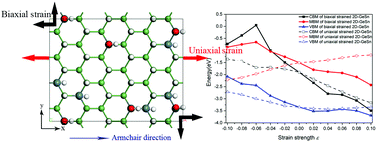Theoretical study of the bandgap regulation of a two-dimensional GeSn alloy under biaxial strain and uniaxial strain along the armchair direction
Abstract
Recently, two-dimensional germanium-tin (2D-GeSn) alloys have attracted considerable attention because they have been predicted to possess a direct bandgap, and this bandgap can be tuned by changing the Sn concentration. However, the tuning efficiency of alloying Sn is still relatively low, and alloying more Sn in 2D-GeSn is difficult to accomplish. To address this issue, the band structures for 2D-GeSn under different strain types (including biaxial and uniaxial strain along the armchair direction, as well as compressive and tensile strain) are investigated using a first-principles method based on density functional theory combined with a GGA+U method and special quasirandom structures. For tensile strain, the results indicate that both biaxially and uniaxially strained 2D-GeSn alloys exhibit direct bandgaps, and their bandgaps decrease as the strain strength increases. The bandgap tuning efficiency for biaxial strain is higher than that for uniaxial strain. For compressive strain, both biaxially and uniaxially strained 2D-GeSn alloys exhibit a large indirect bandgap area, and their bandgaps increase as the strain strength increases; however, their distribution shapes are slightly different. To uncover the physical origin of the difference between them, the projected band, the projected density of the states, the bond length and the bond angle for 2D-GeSn are analyzed. Overall, these results indicate that the combination of alloying Sn and applying an external strain is a good way to reduce the necessary Sn concentration, and this may provide comprehensive theoretical guidance for the strain energy band engineering of 2D-GeSn.



 Please wait while we load your content...
Please wait while we load your content...